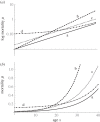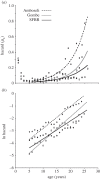Deciphering death: a commentary on Gompertz (1825) 'On the nature of the function expressive of the law of human mortality, and on a new mode of determining the value of life contingencies'
- PMID: 25750242
- PMCID: PMC4360127
- DOI: 10.1098/rstb.2014.0379
Deciphering death: a commentary on Gompertz (1825) 'On the nature of the function expressive of the law of human mortality, and on a new mode of determining the value of life contingencies'
Abstract
In 1825, the actuary Benjamin Gompertz read a paper, 'On the nature of the function expressive of the law of human mortality, and on a new mode of determining the value of life contingencies', to the Royal Society in which he showed that over much of the adult human lifespan, age-specific mortality rates increased in an exponential manner. Gompertz's work played an important role in shaping the emerging statistical science that underpins the pricing of life insurance and annuities. Latterly, as the subject of ageing itself became the focus of scientific study, the Gompertz model provided a powerful stimulus to examine the patterns of death across the life course not only in humans but also in a wide range of other organisms. The idea that the Gompertz model might constitute a fundamental 'law of mortality' has given way to the recognition that other patterns exist, not only across the species range but also in advanced old age. Nevertheless, Gompertz's way of representing the function expressive of the pattern of much of adult mortality retains considerable relevance for studying the factors that influence the intrinsic biology of ageing. This commentary was written to celebrate the 350th anniversary of the journal Philosophical Transactions of the Royal Society.
Keywords: Gompertz law; actuarial science; ageing; demography; mortality.
Figures


References
-
- Miller DP. 2004. Gompertz, Benjamin (1779–1865). In Oxford dictionary of national biography. Oxford, UK: Oxford University Press.
-
- Makeham WM. 1860. On the law of mortality and the construction of annuity tables. J. Inst. Actuar. 8, 301–310.
-
- Makeham WM. 1867. On the law of mortality. J. Inst. Actuar. 13, 325–358.
Publication types
MeSH terms
LinkOut - more resources
Full Text Sources
Other Literature Sources
Medical
